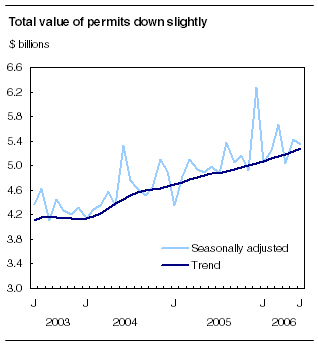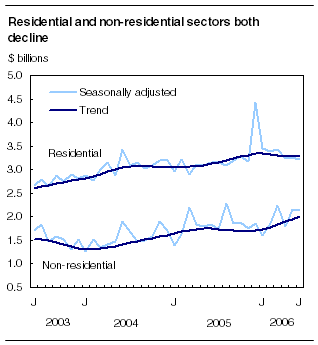Common menu bar links
Building permits
Archived Content
Information identified as archived is provided for reference, research or recordkeeping purposes. It is not subject to the Government of Canada Web Standards and has not been altered or updated since it was archived. Please "contact us" to request a format other than those available.

The value of building permits slipped marginally in June, but the decline would have been much sharper without a burst of industrial projects in Alberta.
Municipalities issued permits worth $5.3 billion in June, down 1.4% from May, as the value of construction intentions in both the residential and non-residential sectors declined.
Even so, the value of permits surpassed the $5.0-billion mark for the seventh consecutive month, and it was 1.0% higher than the average monthly level recorded since the beginning of the year.
Without the exceptional results in Alberta, the picture would have been less rosy. Contractors took out a very high value of permits for industrial construction in Alberta.

If Alberta had been excluded from the national figure, the total value of permits would have declined 7.2%.
Nationally, the total value of residential permits declined 1.3% to $3.2 billion. A decline in the value of multi-family permits more than offset a gain in single-family. After peaking at the end of 2005, the value of residential permits has been on a soft declining trend.
Construction intentions in the non-residential component fell 1.4% to $2.1 billion. A strong gain in the industrial component was more than offset by declines in both the commercial and institutional components.
Note to readersUnless otherwise stated, this release presents seasonally adjusted data, which ease comparisons by removing the effects of seasonal variations. The Building Permits Survey covers 2,380 municipalities representing 95% of the population. It provides an early indication of building activity. The communities representing the other 5% of the population are very small, and their levels of building activity have little impact on the total. The value of planned construction activities shown in this release excludes engineering projects (e.g., waterworks, sewers or culverts) and land. For the purpose of the Building Permits release, the census metropolitan area of Ottawa–Gatineau is divided into two areas: Ottawa–Gatineau (Quebec part) and Ottawa–Gatineau (Ontario part). |
Intentions in the non-residential sector have been on a strong upward trend since the beginning of the year. Values in March, May and June this year were above the $2.0-billion mark.
The value of permits declined 1.0% in the second quarter compared with a quarter earlier. A 7.1% gain in the non-residential sector was more than offset by a 5.5% decline in the residential component.
Regionally, 23 out the 28 census metropolitan areas showed stronger results in the first half of 2006 in comparison with the same period last year. Calgary, Edmonton and Vancouver showed by far the strongest advances (in dollars) due mainly to their dynamic housing market.
Except for St. John's, all metropolitan areas showing retreats in their cumulative value of building permits were in Ontario. Toronto and Hamilton posted the largest declines.
Residential: First increase in five months for single-family permits
Construction intentions for single-family homes increased for the first time in five months in June.
Contractors took out $2.2 billion in single-family permits, up 2.4%. The value of multi-family permits fell 8.2% to $1.1 billion, following a 3.1% increase in May.
The demand for new housing appears to have eased, as the number of units approved declined 5.3% in the second quarter of 2006 in comparison with the first.
The second-quarter retreat came solely from the single-family component, where the number of approvals fell 10.5%. Among the more affordable multi-family units, approvals edged up 0.7%.
The progressive increase in the mortgage rates over the last year seems to have cooled the demand for new housing, especially for the more expensive single-family segment. However, the demand remained high from a historical standpoint, thanks to strong full-time employment and gains in disposable income.
Provincially, the largest retreat (in dollars) in June in the value of housing permits occurred in Ontario (-6.4%) and Quebec (-8.9%). These declines were partly offset by gains in Alberta and British Columbia.

Non-residential: Industrial permits highest in 17 years
Construction intentions in the industrial component hit their highest level in 17 years in June, thanks to a surge in the industrial permits in Alberta.
Municipalities issued $649 million in permits for industrial construction in June, the highest level since 1989. This represented a 69.2% increase from May and a third consecutive monthly gain.
The value of industrial permits was nearly as twice high as the average monthly level for 2005.
In Alberta, contractors took out $306 million worth of industrial permits, nearly half the national total, as a result of construction intentions for utility buildings and plants. This level was the highest on record since February 1988. All provinces posted gains, except for Newfoundland and Labrador and Quebec.
Commercial intentions fell 12.7% to $1.1 billion following a 12.0% gain in May. The decrease came from a decline in the intentions for buildings in the trade and services category, and from projects for hotels and restaurants.
Though highly volatile since the beginning of the year, the value of commercial permits has essentially been on an upward trend since the end of 2005.
The largest declines in the commercial category in June were posted in Ontario (-24.2%) and British Columbia (-21.6%).
In the institutional component, permits plunged 25.4% to $415 million, following a 35.7% gain in May. Declines in the value of permits for schools and in the medical and hospital category fuelled the decrease.
June's level was the second lowest during the last nine months. The largest declines occurred in British Columbia (-53.2%) and Saskatchewan (-76.3%).
The very dynamic economy in Western Canada, robust retail sales, strong corporate operating profits and near-record levels of industrial capacity use contributed to the recent healthy results in the non-residential sector.
Provincially, the largest advance (in dollars) in June in the value of non-residential permits occurred in Alberta, where municipalities authorized a record $613 million worth of non-residential permits, 24.4% higher than the old mark set in March 2006.
This big gain was offset by marked declines in Ontario (-13.9%) and British Columbia (-26.0%).
Available on CANSIM: tables 026-0001 to 026-0008, 026-0010 and 026-0015.
Definitions, data sources and methods: survey number 2802.
The June 2006 issue of Building Permits (64-001-XIE, free) will be available soon.
The July building permit estimate will be released on September 7.
To order data, contact Brad Sernoskie (613-951-4646 or toll-free 1-800-579-8533; bdp_information@statcan.gc.ca). For more information, or to enquire about the concepts, methods or data quality of this release, contact Bechir Oueriemmi (613-951-1165), Investment and Capital Stock Division.


 Table(s).
Table(s).